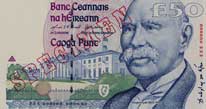
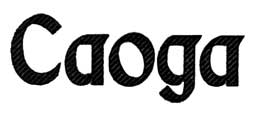
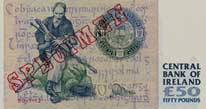
The Central Bank of Ireland Archives, were first opened to public access in 2017, and have provided new source material on the design and production of Irish banknotes. Some content in this article draws on information from the archive. This is referenced as CBIAR in the text.
The Fifty Pound note entered circulation on 3 November 1995, four weeks after its first date of issue. It was the second-last denomination of the Series C banknotes to enter circulation.
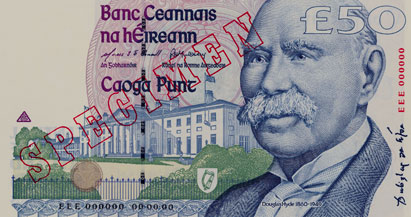
![]()
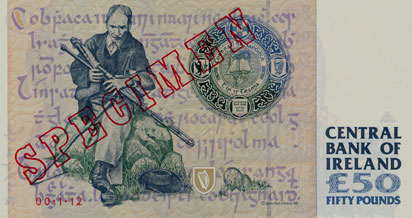
The theme of the Hyde £50 note is the revival of Irish language learning and music. This banknote in particular flows with a strong Irish 'Celtic' feel.
On the face, is the text in Irish 'Banc Ceannais na h-Éireann' (Central Bank of Ireland) 'Nóta dlíthairgthe caoga punt' (Legal tender note fifty pounds). Below the signature are the titles of the signatories in Irish: 'an gobharnóir' (governor) and 'rúnaí na roinne airgeadais' (secretary of the department of finance).
On the last date of the Hyde £50 note, 8 March 2001, the title of the secretary of the department of finance is changed to 'ard-rúnaí na roinne airgeadais'. This is the only Irish bankote bearing this title.
On the right side of the note is a portrait of Douglas Hyde (1860-1949) [2.] by Robert Ballagh, first president of Ireland (1938-1945). He was an Irish scholar with a great interest in the revival of the Irish language, and founded the Gaelic League (Conradh na Gaeilge) in 1893 [3.].
In the background is a design from the interior of the base of the Ardagh Chalice [4.]. Part of a hoard of artifacts discovered near Ardagh, Co Limerick in 1868 [5.], the chalice is one of Ireland's greatest cultural treasures, thought to date from the first half of the 8th century.
Left of the portrait is a drawing of Áras an Uachtaráin [6] (The President's Mansion) in the Phoenix Park, Dublin, the official residence of the President of Ireland. On the walls of the building is the denomination '£50' repeated in microprinting.
A circular latent image is printed in gold/green on the lower left, which when tilted to the light reveals the letters 'IR'. This circular feature is surrounded with the words 'BANCCEANNAISNAHEIREANN' repeated in microprinting.
On the reverse is a drawing of an Uilleann Piper [7.] to the left of the Conradh na Gaeilge crest. Microprinting of the words 'CENTRALBANKOFIRELANDFIFTYPOUNDS' repeated is around the crest of Conradh na Gaeilge.
In the background is a 16th century manuscript, the original of which is held by the Royal Irish Academy.
The Douglas Hyde 50 Pound note was considerably smaller than the Series B Carolan 50 Pound note which it replaced.
The dimensions of Irish pound notes tended to vary by a millimetre or so. The dimensions below are from measurements of actual notes.
Series B, Carolan 50 Pound Note, 180 x 94 mm.
Series C, Douglas Hyde 50 Pound Note, 144 x 76 mm.
Below are illustrated the final date of Series B £50 notes, 05.11.91, and the first date of Series B £50 notes, 16.10.95.

![]()
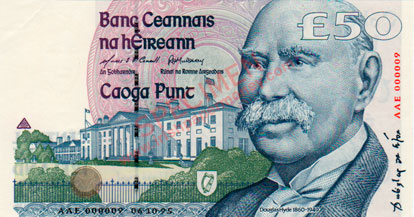
Due to the prominence of the Irish language on the face of the notes, the Series C banknotes were known as the 'Irish Punt series' in many circles. The Douglas Hyde '50 Punt' was a relatively common denomination, often seen in general circulation.
The notes were generally distributed via ATMs, and it was relatively easy to obtain an example in UNC grade.
However, the first date 16.10.95 is significantly scarcer than later dates, due in part to a relatively low printage of only two million notes, prefixes AAE and BAE. Examples of this first date are seldom offered in true UNC (grade 67 or better with quality mark).
The face side if the Hyde Irish 50 pound note is primarily blue with a purple and multicoloured underprint.
The reverse is blue and green on a multicoloured underprint.
Metallic Thread: A metallic security thread is embedded in the paper to the left of center when the note is viewed from the face side. The thread is a 'stardust' security thread, which breaks the surface of the paper on the face of the note at regular intervals. Along the thread is the denomination of the note in numerals, '£50', repeated.
This type of metal security thread remains a standard feature used in banknote manufacture.
Certain areas of the face the Series C Hyde £50 note fluoresce under UV light.
The Hyde 50 Pound note was the second last denomination of Series C to enter circulation.
The note circulated for 7 years until it was replaced by the Euro after Ireland joined the common European currency as a founding member in 2002.
E164. Type 21: Signatures: Muiris S. Ó Conaill. P. Mullarkey. 2 Dates, 2 replacements EEE. 06.10.95, 14.02.96.
E165. Type 22: Signatures: Muiris S. Ó Conaill. P. Mullarkey, serial prefixing system altered. 1 Date, 1 replacement RRR. 19.03.99.
E166. Type 23: Signatures: Muiris S. Ó Conaill. John A. Hurley. 1 Date. 08.03.01

![]()

The two signature varieties of the Series C Central Bank of Ireland 50 pound note
There were only two dates of issue for the Series B £50 note, 01.11.82, and 05.11.91. Neither date was printed with a complete prefix range.
The Douglas Hyde fifty pound notes are common, and easy to obtain. The notes fetch a significant premium in grades EF or better. The first date, 01.11.82 with Ó'Cofaigh, Doyle signatures is common in AU grade. The second date, 05.11.91 with Doyle, Cromien signatures, is much scarcer in grades of AU and better. An image of both dates of issue is on the Series B 50 Pound Note Dates page.
Three dates of the Hyde £50 notes are recorded with replacement note prefixes, two with EEE prefix and one with RRR prefix.
Hyde 50 pound replacement notes are generally uncommon. EEE prefix replacement notes are much scarcer than those with RRR prefix.
References [Last retrieved 04.08.24]
1. Central Bank of Ireland Archives, Dublin. Referred to as CBIAR in the text. [Accessed 24 May 2018].
2. Douglas Hyde (1860-1949). <https://www.dib.ie/biography/hyde-douglas-de-hide-dubhghlas-a4185>
3. Gaelic League (Conradh na Gaeilge). <https://www.nli.ie/1916/exhibition/en/content/stagesetters/culture/hyde-macneill>
<https://exhibitions.lib.udel.edu/easter1916/home/gaelic-revival/gaelic-league>
4. Ardagh Chalice <https://www.museum.ie/en-IE/Collections-Research/Collection/The-Treasury/Artefact/The-Ardagh-Chalice/ac53e68e-76a4-4560-a624-c87647c57a00>
5. Discovered of Ardagh Chalice near Ardagh, Co Limerick in 1868 <https://www.britannica.com/topic/Ardagh-Chalice>
6. Áras an Uachtaráin. <https://www.president.ie/en/explore-visit/the-house>
7. Uilleann Piper. <https://pipers.ie/about/history>
1 Pound Ploughman
5 Pounds Ploughman
10 Pounds Ploughman
20 Pounds Ploughman
50 Pounds Ploughman
100 Pounds Ploughman
Irish Ten Shilling Notes
1 Pound Note Lady Lavery
5 Pounds Lady Lavery
10 Pounds Lady Lavery
20 Pounds Lady Lavery
50 Pounds Lady Lavery
100 Pounds Lady Lavery
1 Pound Note, Queen Medb
5 Pound Note, John Scotus Eriugena
10 Pound Note, Jonathan Swift
20 Pound Note, W. B. Yeats
50 Pound Note, Turlough O'Carolan
100 Pound Note, Grace O'Malley
5 Pound Note, Sister Catherine McAuley
10 Pound Note, James Joyce
20 Pound Note, Daniel O'Connell
50 Pound Note, Douglas Hyde
100 Pound Note, Charles Stewart Parnell
Northen Ireland Polymer notes
Bank of Ireland Polymer Notes
Danske Bank Polymer Notes
Ulster Bank Polymer Notes
Special Sections and Articles
The Transition of Irish Currency, Irish banknotes 1918–1928
The Partition of Irish Currency, Irish banknotes 1928–1930
Banknote Design Evolution 1824 to 1916
Irish Three Pound Notes
Contemporary Forgeries of Early Irish Banknotes, ca1800-1930
Limerick Soviet Notes
Irish World War 2 Banknote Issues
Low Number Irish Banknotes
Irish Joint Stock Banks of Note Issue from 1783
Irish Legal Tender Note Specimens
Ploughman Scan Survey (PSS)
![]() Stable version. Last update 23.08.24.
Stable version. Last update 23.08.24.